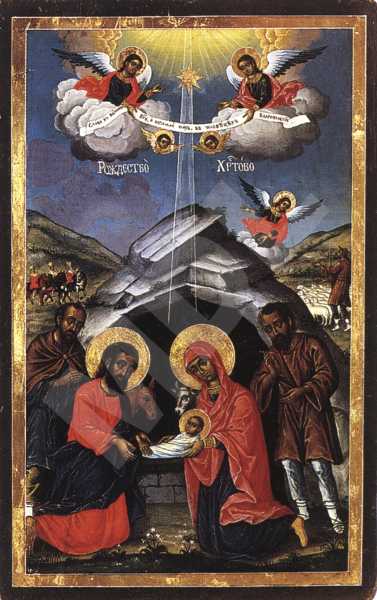The Nativity of Christ
Type:
Icon
Period:
1861 year
Dimiter T. Molerov, born in 1780 in Bansko, son of Toma Vishanov the Moler. One of the best-known painters, a representative of the Bansko school of art, a disciple of his father, influenced by the art of Athos. Author of the murals of the naos in the St Archangels' paraclete in the Rila monastery, the murals in the Church of the Assumption of the Virgin in the Pchelino dependance. In 1840 and 1841 together with his son Simeon Molerov he paints the murals and the sponsors' portraits in St. Nicholas' and St. John of Rila's paracletes in the principal church in the Rila monastery. Among D. Molerov's major achievements in iconography are the following icons: St. Nicholas (1816) from St. Archangel Michael's church in the village of Leshko, Christ All-triumphant with Angels and Cherubim (1833), The Nativity and a Crucifixion from St Elijah the Prophet's church in the village of Usenovo. He has also worked in Belgrade on an invitation by Prince Milosh Obrenovich of Serbia. He died in 1870 in Bansko.
Dimmensions (cm):
47
/ 30
/ 2.5
Location
Country: Bulgaria
Province: Blagoevgrad
Village: Gostun
Church: St. Prophet Elijah
Source
Country: Bulgaria
Province: Blagoevgrad
Village: Gostun
Church: St. Prophet Elijah
Object identification notes
Dimiter Molerov (?)
Description
A traditionally developed composition on the theme of "The Nativity of Christ". In the foreground are the Holy Mother of God and Joseph the Righteous One with the swaddled Christ in his hands. Behind them are the shepherds, under the impression of the event that had taken place in the small grot¬to. The latter is painted conventionally behind the figures of the Holy Family. Painted in a small scale in the second distance are the three wise men on horseback, and on the right-hand side - a shepherd with a flock of sheep. High up two archangels are holding a roll with a text on it, and in the space between them is the shining star of Bethlehem.
Iconographical technique: Tempera
With gilding. The varnish cover is thin, applied unevenly and with onflowings.
Base material: Wood
The icon's base is a softwood panel with two beams, mounted on its reverse side. Trie ground coat is of plaster, laid thinly, damaged on the left-hand side under the blue background, the mountain, the aureoles, the frame and the rocks.
State, restoration traces and comments
The layer of the painting is with partial damages of the paint and of the ground coat, especially in the areas of the gilding.
In the icon's lower left corner the iconographer has marked the year of its painting - 1861.
There are no traces of any previous restoration work.


